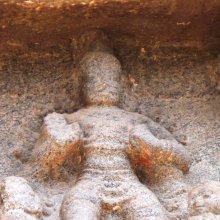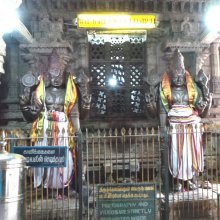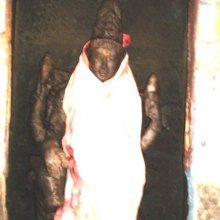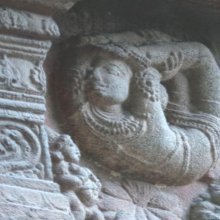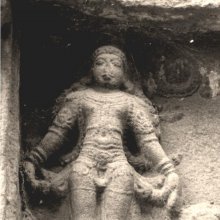Natya, Nāṭya, Naṭyā: 21 definitions
Introduction:
Natya means something in Buddhism, Pali, Hinduism, Sanskrit, the history of ancient India, Marathi, Hindi. If you want to know the exact meaning, history, etymology or English translation of this term then check out the descriptions on this page. Add your comment or reference to a book if you want to contribute to this summary article.
Images (photo gallery)
(+33 more images available)
In Hinduism
Natyashastra (theatrics and dramaturgy)
Source: Wisdom Library: Nāṭya-śāstraNāṭya (नाट्य) is a Sanskrit technical term, referring to “dramatic art”. According to the Nāṭyaśāstra 1.106, “In it (nāṭya) there is no exclusive representation of you or of the Gods: for the drama is a representation of the States (bhāvānukīrtana) of the three worlds”.Also, “a mimicry of the exploits of gods, the Asuras, kings as well as of householders in this world, is called drama (nāṭya)”. (I. 120)
Source: archive.org: The mirror of gesture (abhinaya-darpana)Nāṭya is dancing used in a drama (nāṭaka) combined with the original plot. Nātya and Nṛtya should be seen especially at festivals.
Source: Indian Classical Dances: Techniques of classical dancesNatya is the dramatic element. Natya is exhaustive. It includes both Nrita and Nritya and in addition, it has the element of drama, which is introduced through speech and song. The Vachika (voice) and Aharya (costume) aspects of Abhinaya are more pertinent to Natya then to Nrita and Nritya. When Natya Shasta was arranged, no dance was independent of drama. The performer was compelled to present both dancer and actor.
Source: Shodhganga: The significance of the mūla-beras (natya)Nāṭya refers to “dramatic representation” as used within the classical tradition of Indian dance and performance, also known as Bharatanatyam.—According to the Abhinayadarpaṇa, verse 16, “nāṭya or nāṭaka, which has some traditional story for its theme, is an adorable art”. The word nāṭya is derived from ‘naṭ’ meaning to move or to act. It is a presentation on the stage of a play full of ancient stories and is adorable with all the four elements of abhinaya (histrionic representation)–āṅgika, āhārya, sāttvika and vācika. It also indicates a dance drama through the medium of any classical dance style. The use of speech makes nāṭya the most comprehensive part of the three. Nāṭya means dramatic representation with speech, music, and dancing.
Nāṭya has a two-fold division: tāṇḍava and lāsya.

Natyashastra (नाट्यशास्त्र, nāṭyaśāstra) refers to both the ancient Indian tradition (shastra) of performing arts, (natya—theatrics, drama, dance, music), as well as the name of a Sanskrit work dealing with these subjects. It also teaches the rules for composing Dramatic plays (nataka), construction and performance of Theater, and Poetic works (kavya).
Kosha (encyclopedic lexicons)
Source: Google Books: Kalātattvakośa, volume 2Nāṭya (नाट्य):—“Nāṭya (drama) is the anukīrtana (restatement) of the bhāva (mental or inner state) of the totality of the three worlds.” (Nāṭyaśāstra I.107cd).
And also: “This Nāṭya (drama) has been created by me which is rich with various bhāvas (mental states), is full of many situations and is representational of the totality of human life (loka-vṛtta).” (Nāṭyaśāstra I.112)
And also: “The nature of loka (people) associated with pleasure and pain, when that is presented through abhinaya (acting) with aṅga (body) etc., it is called Nāṭya (drama)” (Nāṭyaśāstra I.119)
Kosha (कोश, kośa) refers to Sanskrit lexicons intended to provide additional information regarding technical terms used in religion, philosophy and the various sciences (shastra). The oldest extant thesaurus (kosha) dates to the 4th century AD.
Shaivism (Shaiva philosophy)
Source: SOAS University of London: Protective Rites in the Netra TantraNāṭya (नाट्य) or Nāṭyastha refers to a “dance (position)” (e.g., having one’s arms posed in a dance position), according to the Netratantra of Kṣemarāja: a Śaiva text from the 9th century in which Śiva (Bhairava) teaches Pārvatī topics such as metaphysics, cosmology, and soteriology.—Accordingly, [verse 13.29-36, while describing the appearance and worship of Rudra]—“[...] [Rudra] has noble nature [and holds] a spike for safety. Carrying a citrus tree, mighty Deva [also] has a rosary. Now, [the Mantrin] should think [so that] Deva appears, his many arms posed in a dance [position] (nāṭya-stha—bahubhujaṃ devaṃ nāṭyasthaṃ). [The Mantrin meditates on Rudra] who holds Umā at [his] side. Or [the Mantrin visualizes Rudra] as half of Viṣṇu. [Or finally, the Mantrin visualizes Rudra as] taking a bride. [The Mantrin] worships him nearby”.

Shaiva (शैव, śaiva) or Shaivism (śaivism) represents a tradition of Hinduism worshiping Shiva as the supreme being. Closely related to Shaktism, Shaiva literature includes a range of scriptures, including Tantras, while the root of this tradition may be traced back to the ancient Vedas.
Kama-shastra (the science of Love-making)
Source: Shodhganga: Elements of Art and Architecture in the Trtiyakhanda of the Visnudharmottarapurana (kama)Nāṭya (नाट्य) or “drama” refers to one of the “sixty four kinds of Art”, according to the Kāmasūtra of Vātsyāyaṇa.—Indian tradition, basically includes sixty four Art forms are acknowledged. The references of sixty four kinds of kalā are found in the Bhāgavatapurāṇa, Śaiva-Tantras, Kāmasūtra of Vātsyāyaṇa etc.
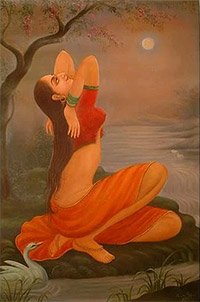
Kamashastra (कामशास्त्र, kāmaśāstra) deals with ancient Indian science of love-making, passion, emotions and other related topics dealing with the pleasures of the senses.
In Buddhism
Tibetan Buddhism (Vajrayana or tantric Buddhism)
Source: academia.edu: A Critical Study of the Vajraḍākamahātantrarāja (II)Nāṭya (नाट्य) refers to “dance” (sexual yoga) in Tantric Buddhism, according to the 9th-century Vajraḍākatantra. Accordingly, chapter 36 argues concisely about the content of the meeting (melā), focussing particularly on the importance of the sexual yoga. Every day, every month or every year, or in accordance with the time when “empowerment” arises in one’s body, a Yogin should perform ‘dance’ (nāṭya) (=sexual yoga) to obtain the accomplishment of mudrā. He grasps the vessel of the lotus (according to the commentary, pañcāmṛta is in it) in his left hand and his right hand shows the tripatākā sign. Various kinds of ornaments are given to all Yogins who have been admitted as the Master (Ācārya). Then the very happy yogin should begin the tantric ‘dance’.
If a Yogin does not practise the sexual yoga for (more than) one year, his samaya will have gone. In that case, he should hold the punarakaraṇasaṃvara. This is because touching Yoginīs brings a Yogin the effects of practices of mantras and tantras.

Tibetan Buddhism includes schools such as Nyingma, Kadampa, Kagyu and Gelug. Their primary canon of literature is divided in two broad categories: The Kangyur, which consists of Buddha’s words, and the Tengyur, which includes commentaries from various sources. Esotericism and tantra techniques (vajrayāna) are collected indepently.
India history and geography
Source: archive.org: Natya Shastra (history)Nāṭya has often been translated as ‘drama’ and the plays of ancient India have indeed some points of similarity with those of the Greeks. But on a closer examination of the technique of their production as described in the Nāṭyaśāstra, the Hindu dramas represented by the available specimens, will appear to be considerably different.

The history of India traces the identification of countries, villages, towns and other regions of India, as well as mythology, zoology, royal dynasties, rulers, tribes, local festivities and traditions and regional languages. Ancient India enjoyed religious freedom and encourages the path of Dharma, a concept common to Buddhism, Hinduism, and Jainism.
Languages of India and abroad
Marathi-English dictionary
Source: DDSA: The Molesworth Marathi and English Dictionarynāṭya (नाट्य).—n S Dancing, acting, gesticulating, dramatic performance. 2 Dancing, playing a part, vocal and instrumental music as in combination or union.
Source: DDSA: The Aryabhusan school dictionary, Marathi-Englishnāṭya (नाट्य).—n Dancing, acting. Playing a part, vocal and instrumental music as in combination or union.
Marathi is an Indo-European language having over 70 million native speakers people in (predominantly) Maharashtra India. Marathi, like many other Indo-Aryan languages, evolved from early forms of Prakrit, which itself is a subset of Sanskrit, one of the most ancient languages of the world.
Sanskrit dictionary
Source: DDSA: The practical Sanskrit-English dictionaryNaṭyā (नट्या).—A company of actors.
--- OR ---
Nāṭya (नाट्य).—[naṭasyedaṃ kṛtyaṃ ṣyañ]
1) Dancing.
2) Dramatic representation, gesticulation; acting; नाट्ये च दक्षा वयम् (nāṭye ca dakṣā vayam) Ratnāvalī 1.6; नूनं नाट्ये भवति च चिरं नोर्वशी गर्वशीला (nūnaṃ nāṭye bhavati ca ciraṃ norvaśī garvaśīlā) Vikr. 18.29.
3) The science or art of dancing or acting, scenic art; नाट्यं भिन्नरुचेर्जनस्य बहुधाप्येकं समाराधनम् (nāṭyaṃ bhinnarucerjanasya bahudhāpyekaṃ samārādhanam) M.1.4.
4) The costume of an actor; न लक्ष्यसे मूढदृशा नटो नाट्यधरो यथा (na lakṣyase mūḍhadṛśā naṭo nāṭyadharo yathā) Bhāgavata 1.8.19.
-ṭyaḥ An actor.
Derivable forms: nāṭyam (नाट्यम्).
Source: Cologne Digital Sanskrit Dictionaries: Shabda-Sagara Sanskrit-English DictionaryNāṭya (नाट्य).—n.
(-ṭyaṃ) The science or art of dancing or acting, or the union of song, dance, and instrumental music. E. naṭ to dance, affix ṇyat or jya, or naṭānāṃ karma ṣyañ .
Source: Cologne Digital Sanskrit Dictionaries: Benfey Sanskrit-English DictionaryNāṭya (नाट्य).—i. e. naṭa + ya, n. 1. The art of acting or dancing, scenic art, [Bhāgavata-Purāṇa, (ed. Burnouf.)] 4, 15, 19. 2. Mimical representation, [Mṛcchakaṭikā, (ed. Stenzler.)] 88, 4. 3. The attire of an actor, [Bhāgavata-Purāṇa, (ed. Burnouf.)] 1, 8, 19.
Source: Cologne Digital Sanskrit Dictionaries: Cappeller Sanskrit-English DictionaryNāṭya (नाट्य).—[neuter] dancing, mimic representation.
Source: Cologne Digital Sanskrit Dictionaries: Monier-Williams Sanskrit-English Dictionary1) Naṭyā (नट्या):—[from naṭ] f. a company of actors [gana] pāśādi.
2) Nāṭya (नाट्य):—[from nāṭa] n. dancing, mimic representation, dramatic art, [Kāvya literature; Purāṇa] etc. (ṭyena ind. with a gesture, [Kālidāsa] etc.)
3) [v.s. ...] the costume of an actor, [Bhāgavata-purāṇa] (cf. below).
Source: Cologne Digital Sanskrit Dictionaries: Yates Sanskrit-English DictionaryNāṭya (नाट्य):—(ṭyaṃ) 1. n. The science or art of acting or dancing.
[Sanskrit to German]
Sanskrit, also spelled संस्कृतम् (saṃskṛtam), is an ancient language of India commonly seen as the grandmother of the Indo-European language family (even English!). Closely allied with Prakrit and Pali, Sanskrit is more exhaustive in both grammar and terms and has the most extensive collection of literature in the world, greatly surpassing its sister-languages Greek and Latin.
Hindi dictionary
Source: DDSA: A practical Hindi-English dictionaryNāṭya (नाट्य) [Also spelled naty]:—(a) dramatic; histrionic; ~[kalā] dramatic art, histrionics; ~[kāra] a dramatist, playwright; an actor; a performer (of a play); ~[śālā] a theatre; -[śāstra] dramaturgy; ~[śāstrī] dramaturgist; ~[śilpa] stagecraft, the art of theatre; hence ~[śilpī] (nm).
...
Kannada-English dictionary
Source: Alar: Kannada-English corpusNāṭya (ನಾಟ್ಯ):—
1) [noun] dancing, mimic representation.
2) [noun] dramatic art.
3) [noun] a combination of dance, song and instrumental music.
4) [noun] a dancer or actor.
Kannada is a Dravidian language (as opposed to the Indo-European language family) mainly spoken in the southwestern region of India.
See also (Relevant definitions)
Starts with (+50): Natya arambh, Natya-krama, Natyacarya, Natyacaryaka, Natyacharya, Natyachata, Natyadarpana, Natyadhara, Natyadharma, Natyadharmi, Natyadharmika, Natyadharmmika, Natyadrita, Natyagama, Natyagara, Natyagati, Natyagriha, Natyaka, Natyakara, Natyakirna.
Ends with: Adakshinatya, Anatya, Aunnatya, Bharatanatya, Dakshinatya, Ghanatya, Kutanatya, Lokanatya, Mahanatya, Mukanatya, Nica-natya, Rudranatya, Samnatya, Sunatya, Vainatya, Vishnudatta dakshinatya.
Full-text (+540): Natyapriya, Natyashala, Natyaveda, Natyacarya, Nritya, Natyashastra, Natyavedi, Natyadharmika, Trimudhaka, Natara, Uttamottamaka, Anatya, Varicci, Pushpagandika, Natera, Natyalocanakara, Abhinaya, Natyadarpana, Natyapradipa, Natyalocana.
Relevant text
Search found 37 books and stories containing Natya, Nāṭya, Naṭyā; (plurals include: Natyas, Nāṭyas, Naṭyās). You can also click to the full overview containing English textual excerpts. Below are direct links for the most relevant articles:
Mudrarakshasa (literary study) (by Antara Chakravarty)
4. The entity of Vṛtti and its use in Mudrārākṣasa < [Chapter 5 - Adoption of Style and Language in Mudrārākṣasa]
6. Subhāśitas occuring in Mudrārākṣasa < [Chapter 5 - Adoption of Style and Language in Mudrārākṣasa]
Gati in Theory and Practice (by Dr. Sujatha Mohan)
Analysis of technical terms: Nāṭya, Nṛtta, Nṛtya < [Chapter 1 - Nāṭya]
Manifestation of Gati in Cārīs and Karaṇas (Introduction) < [Chapter 2 - Concept and technique of Gati]
Rasa-nishpatti—The goal of Natya < [Chapter 1 - Nāṭya]
Dasarupaka (critical study) (by Anuru Ranjan Mishra)
The concise nature of the Daśarūpaka < [Introduction]
Difference between the Daśarūpaka and the Nāṭyaśāstra < [Introduction]
The description of rūpa, rūpaka, nāṭya, nṛtya and nṛtta < [Introduction]
Amarakoshodghatana of Kshirasvamin (study) (by A. Yamuna Devi)
Three types of Dance < [Chapter 4 - Cultural Aspects]
Music (Nāṭya-varga) < [Chapter 4 - Cultural Aspects]
Amarakośa of Amarasiṃha < [Chapter 1 - Kośa Literature–A Brief Survey]
Abhinaya-darpana (English) (by Ananda Coomaraswamy)
Painting and Natya < [May-June 1935]
When Stones Dance < [January – March 1992]
Natya, the Celestial Art of Ancient India < [July 1939]
